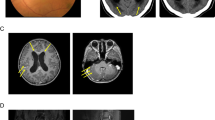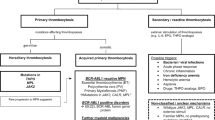Abstract
Thrombopoietin (THPO) is an essential factor for platelet production. Hereditary thrombocythemia (HT) is caused by a germline mutation of THPO, MPL, or JAK2 and is inherited in an autosomal-dominant manner. We identified a Japanese family with HT due to a point mutation of the splicing donor site of the THPO gene (THPO c.13 + 1G > A). Bone marrow biopsy showed increased megakaryocytes mimicking essential thrombocythemia. One affected family member developed chronic myeloid leukemia. We cloned the mutation and developed mutated and wild type THPO expression vectors. Molecular analysis showed that the mutation causes an exon 3 skipping transcript of THPO that abrogates a suppressive untranslated upstream open reading frame. Although the transcript levels of THPO mRNA were comparable, mutated transcripts were more efficiently translated and THPO protein expression was significantly higher than that of the wild type.



Similar content being viewed by others
Data availability
The data sets generated and/or analyzed during the current study are available from the corresponding author upon reasonable request.
References
Kaushansky K (1998) Thrombopoietin. N Engl J Med 339(11):746–754. https://doi.org/10.1056/NEJM199809103391107
Kaushansky K (2006) Lineage-specific hematopoietic growth factors. N Engl J Med 354(19):2034–2045. https://doi.org/10.1056/NEJMra052706
Harrison CN, Gale RE, Wiestner AC, Skoda RC, Linch DC (1998) The activating splice mutation in intron 3 of the thrombopoietin gene is not found in patients with non-familial essential thrombocythaemia. Br J Haematol 102(5):1341–1343
Wiestner A, Schlemper RJ, van der Maas AP, Skoda RC (1998) An activating splice donor mutation in the thrombopoietin gene causes hereditary thrombocythaemia. Nat Genet 18(1):49–52. https://doi.org/10.1038/ng0198-49
Kondo T, Okabe M, Sanada M, Kurosawa M, Suzuki S, Kobayashi M, Hosokawa M, Asaka M (1998) Familial essential thrombocythemia associated with one-base deletion in the 5’-untranslated region of the thrombopoietin gene. Blood 92(4):1091–1096
Jorgensen MJ, Raskind WH, Wolff JF, Bachrach HR, Kaushansky K (1998) Familial thrombocytosis associated with overproduction of thrombopoietin due to a novel splice donor site mutation. Blood (ASH Meeting Abstracts) 92(205):Abstract #834
Ghilardi N, Wiestner A, Kikuchi M, Ohsaka A, Skoda RC (1999) Hereditary thrombocythaemia in a Japanese family is caused by a novel point mutation in the thrombopoietin gene. Br J Haematol 107(2):310–316. https://doi.org/10.1046/j.1365-2141.1999.01710.x
Ghilardi N, Skoda RC (1999) A single-base deletion in the thrombopoietin (TPO) gene causes familial essential thrombocythemia through a mechanism of more efficient translation of TPO mRNA. Blood 94(4):1480–1482
Liu K, Kralovics R, Rudzki Z, Grabowska B, Buser AS, Olcaydu D, Gisslinger H, Tiedt R, Frank P, Okon K, van der Maas AP, Skoda RC (2008) A de novo splice donor mutation in the thrombopoietin gene causes hereditary thrombocythemia in a Polish family. Haematologica 93(5):706–714. https://doi.org/10.3324/haematol.11801
Graziano C, Carone S, Panza E, Marino F, Magini P, Romeo G, Pession A, Seri M (2009) Association of hereditary thrombocythemia and distal limb defects with a thrombopoietin gene mutation. Blood 114(8):1655–1657. https://doi.org/10.1182/blood-2009-04-217851
Zhang B, Ng D, Jones C, Oh ST, Nolan GP, Salehi S, Wong W, Zehnder JL, Gotlib J (2011) A novel splice donor mutation in the thrombopoietin gene leads to exon 2 skipping in a Filipino family with hereditary thrombocythemia. Blood 118(26):6988–6990. https://doi.org/10.1182/blood-2011-10-386177
Stockklausner C, Echner N, Klotter AC, Hegenbart U, Dreger P, Kulozik AE (2012) Hereditary thrombocythemia caused by a thrombopoietin (THPO) gain-of-function mutation associated with multiple myeloma and congenital limb defects. Ann Hematol 91(7):1129–1133. https://doi.org/10.1007/s00277-012-1453-y
Prouzet-Mauleon V, Montibus B, Chauveau A, Hautin M, Migeon M, Ka C, Laharanne E, Bidet A, Corcos L, Lippert E (2020) A novel thrombopoietin (THPO) mutation altering mRNA splicing in a case of familial thrombocytosis. Br J Haematol 190(2):e104–e107. https://doi.org/10.1111/bjh.16742
Jung N, Kim DH, Ha JS, Shim YJ (2020) Thrombocythemia 1 with THPO variant (c.13+1G>A) diagnosed using targeted exome sequencing: first case in Korea. Ann Lab Med 40(4):341–344. https://doi.org/10.3343/alm.2020.40.4.341
Moliterno AR, Williams DM, Gutierrez-Alamillo LI, Salvatori R, Ingersoll RG, Spivak JL (2004) Mpl Baltimore: a thrombopoietin receptor polymorphism associated with thrombocytosis. Proc Natl Acad Sci U S A 101(31):11444-11447.https://doi.org/10.1073/pnas.0404241101
Ding J, Komatsu H, Iida S, Yano H, Kusumoto S, Inagaki A, Mori F, Ri M, Ito A, Wakita A, Ishida T, Nitta M, Ueda R (2009) The Asn505 mutation of the c-MPL gene, which causes familial essential thrombocythemia, induces autonomous homodimerization of the c-Mpl protein due to strong amino acid polarity. Blood 114(15):3325–3328. https://doi.org/10.1182/blood-2008-04-149047
Liu K, Martini M, Rocca B, Amos CI, Teofili L, Giona F, Ding J, Komatsu H, Larocca LM, Skoda RC (2009) Evidence for a founder effect of the MPL-S505N mutation in eight Italian pedigrees with hereditary thrombocythemia. Haematologica 94(10):1368–1374. https://doi.org/10.3324/haematol.2009.005918
el El-Harith HA, Roesl C, Ballmaier M, Germeshausen M, Frye-Boukhriss H, von Neuhoff N, Becker C, Nurnberg G, Nurnberg P, Ahmed MA, Hubener J, Schmidtke J, Welte K, Stuhrmann M (2009) Familial thrombocytosis caused by the novel germ-line mutation p.Pro106Leu in the MPL gene. Br J Haematol 144(2):185–194. https://doi.org/10.1111/j.1365-2141.2008.07430.x
Teofili L, Giona F, Torti L, Cenci T, Ricerca BM, Rumi C, Nunes V, Foa R, Leone G, Martini M, Larocca LM (2010) Hereditary thrombocytosis caused by MPLSer505Asn is associated with a high thrombotic risk, splenomegaly and progression to bone marrow fibrosis. Haematologica 95(1):65–70. https://doi.org/10.3324/haematol.2009.007542
Bellanne-Chantelot C, Mosca M, Marty C, Favier R, Vainchenker W, Plo I (2017) Identification of MPL R102P mutation in hereditary thrombocytosis. Front Endocrinol (Lausanne) 8:235. https://doi.org/10.3389/fendo.2017.00235
Al-Harbi T, Al-Zahrani M, Al-Balwi M, Al-Hazmi A, Alsuhaibani A, Aljafn N, Alsumari F, Aleshaiwi L, Alsuhibani A, Alqasim O, Ahmad N (2021) Clinical course of myeloproliferative leukaemia virus oncogene (MPL) mutation-associated familial thrombocytosis: a review of 64 paediatric and adult patients. Br J Haematol 194(5):893–898. https://doi.org/10.1111/bjh.17624
Rendo M, Cavacece C, Kou CJ, Beeler BW, Fenderson J (2022) Familial essential thrombocythemia with novel MPL L502G and G208K mutations. Cureus 14(3):e23220. https://doi.org/10.7759/cureus.23220
Vasseur L, Favier R, Kim R, Rabian F, Cabannes-Hamy A, Cassinat B, Maslah N, Vasquez N, Clappier E, Kiladjian JJ, Boissel N (2023) Clonal evolution in hereditary thrombocytosis with MPL T487A mutation. Pediatr Blood Cancer 70(2):e29905. https://doi.org/10.1002/pbc.29905
Mead AJ, Rugless MJ, Jacobsen SE, Schuh A (2012) Germline JAK2 mutation in a family with hereditary thrombocytosis. N Engl J Med 366(10):967–969. https://doi.org/10.1056/NEJMc1200349
Etheridge SL, Cosgrove ME, Sangkhae V, Corbo LM, Roh ME, Seeliger MA, Chan EL, Hitchcock IS (2014) A novel activating, germline JAK2 mutation, JAK2R564Q, causes familial essential thrombocytosis. Blood 123(7):1059–1068. https://doi.org/10.1182/blood-2012-12-473777
Marty C, Saint-Martin C, Pecquet C, Grosjean S, Saliba J, Mouton C, Leroy E, Harutyunyan AS, Abgrall JF, Favier R, Toussaint A, Solary E, Kralovics R, Constantinescu SN, Najman A, Vainchenker W, Plo I, Bellanne-Chantelot C (2014) Germ-line JAK2 mutations in the kinase domain are responsible for hereditary thrombocytosis and are resistant to JAK2 and HSP90 inhibitors. Blood 123(9):1372–1383. https://doi.org/10.1182/blood-2013-05-504555
Rumi E, Harutyunyan AS, Casetti I, Pietra D, Nivarthi H, Moriggl R, Cleary C, Bagienski K, Astori C, Bellini M, Berg T, Passamonti F, Kralovics R, Cazzola M (2014) A novel germline JAK2 mutation in familial myeloproliferative neoplasms. Am J Hematol 89(1):117–118. https://doi.org/10.1002/ajh.23614
Yoshimitsu M, Hachiman M, Uchida Y, Arima N, Arai A, Kamada Y, Shide K, Ito M, Shimoda K, Ishitsuka K (2019) Essential thrombocytosis attributed to JAK2-T875N germline mutation. Int J Hematol 110(5):584–590. https://doi.org/10.1007/s12185-019-02725-8
Kanda Y (2013) Investigation of the freely available easy-to-use software “EZR” for medical statistics. Bone Marrow Transplant 48(3):452–458. https://doi.org/10.1038/bmt.2012.244
Han EY, Catherwood M, McMullin MF (2021) Hereditary thrombocytosis: the genetic landscape. Br J Haematol 194(6):1098–1105. https://doi.org/10.1111/bjh.17741
Nelson ND, Marcogliese A, Bergstrom K, Scheurer M, Mahoney D, Bertuch AA (2016) Thrombopoietin measurement as a key component in the evaluation of pediatric thrombocytosis. Pediatr Blood Cancer 63(8):1484–1487. https://doi.org/10.1002/pbc.26032
Fielder PJ, Hass P, Nagel M, Stefanich E, Widmer R, Bennett GL, Keller GA, de Sauvage FJ, Eaton D (1997) Human platelets as a model for the binding and degradation of thrombopoietin. Blood 89(8):2782–2788
Kuter DJ, Beeler DL, Rosenberg RD (1994) The purification of megapoietin: a physiological regulator of megakaryocyte growth and platelet production. Proc Natl Acad Sci U S A 91(23):11104-11108. https://doi.org/10.1073/pnas.91.23.11104
Kuter DJ (2013) The biology of thrombopoietin and thrombopoietin receptor agonists. Int J Hematol 98(1):10–23. https://doi.org/10.1007/s12185-013-1382-0
Zhang Y, Xi X, Yu H, Yang L, Lin J, Yang W, Liu J, Fan X, Xu Y (2022) Chemically modified in-vitro-transcribed mRNA encoding thrombopoietin stimulates thrombopoiesis in mice. Mol Ther Nucleic Acids 29:657–671. https://doi.org/10.1016/j.omtn.2022.08.017
Teofili L, Larocca LM (2011) Advances in understanding the pathogenesis of familial thrombocythaemia. Br J Haematol 152(6):701–712. https://doi.org/10.1111/j.1365-2141.2010.08500.x
Posthuma HL, Skoda RC, Jacob FA, van der Maas AP, Valk PJ, Posthuma EF (2010) Hereditary thrombocytosis not as innocent as thought? Development into acute leukemia and myelofibrosis. Blood 116(17):3375–3376. https://doi.org/10.1182/blood-2010-06-290718
Kikuchi M, Tayama T, Hayakawa H, Takahashi I, Hoshino H, Ohsaka A (1995) Familial thrombocytosis. Br J Haematol 89(4):900–902
Piccin A, Corvetta D, Rovigatti U, Mazzoleni G, Pusceddu I, Svaldi M, Steurer M, Gastl G, Cortelazzo S (2014) Essential thrombocytemia progressing to Ph+ chronic myeloid leukemia with megakaryoblastic blasts, following anagrelide withdrawal. Platelets 25(8):646–647. https://doi.org/10.3109/09537104.2013.858112
Xia D, Hsi ED, Dal Cin P, Hasserjian RP (2019) Composite chronic myeloid leukemia and essential thrombocythemia with BCR-ABL1 fusion and CALR mutation. Am J Hematol 94(4):504–505. https://doi.org/10.1002/ajh.25249
Mizutani S, Kuroda J, Shimizu D, Horiike S, Taniwaki M (2010) Emergence of chronic myelogenous leukemia during treatment for essential thrombocythemia. Int J Hematol 91(3):516–521. https://doi.org/10.1007/s12185-010-0502-3
Schlemper RJ, van der Maas AP, Eikenboom JC (1994) Familial essential thrombocythemia: clinical characteristics of 11 cases in one family. Ann Hematol 68(3):153–158
Acknowledgements
We thank Dr. Hiroshi Ikeda (Sapporo Medical College) for providing information about ii1 patient under consent of family member.
Funding
This work was supported by research budget of Department of Hematology, Hokkaido University Faculty of Medicine.
Author information
Authors and Affiliations
Contributions
H. K. and M. O. designed the study, analyzed the data, and wrote the manuscript. H. K., J. H., and D. H. performed experiments. H. O. and Y. M. verified pathological finding of bone marrow biopsy. M. K., T. M., and K. T. were involved in the critical evaluation of the manuscript and data presentation. T. T. revised and approved the manuscript.
Corresponding author
Ethics declarations
Ethics approval
All procedures performed in studies involving human participants were in accordance with the ethical standards of the institutional and/or national research committee and with the 1964 Helsinki declaration and its later amendments or comparable ethical standards. This study was approved by the Institutional Review Board of Hokkaido University Faculty of Medicine (IRB#17–037).
Informed consent
Informed consent was obtained from all individual participants included in the study. Written informed consent was obtained from each family member in accordance with the Declaration of Helsinki.
Conflict of interest
The authors declare no competing interests.
Additional information
Publisher's Note
Springer Nature remains neutral with regard to jurisdictional claims in published maps and institutional affiliations.
Rights and permissions
Springer Nature or its licensor (e.g. a society or other partner) holds exclusive rights to this article under a publishing agreement with the author(s) or other rightsholder(s); author self-archiving of the accepted manuscript version of this article is solely governed by the terms of such publishing agreement and applicable law.
About this article
Cite this article
Kimura, H., Onozawa, M., Hashiguchi, J. et al. Hereditary thrombocythemia due to splicing donor site mutation of THPO in a Japanese family. Ann Hematol 103, 89–96 (2024). https://doi.org/10.1007/s00277-023-05523-9
Received:
Accepted:
Published:
Issue Date:
DOI: https://doi.org/10.1007/s00277-023-05523-9




